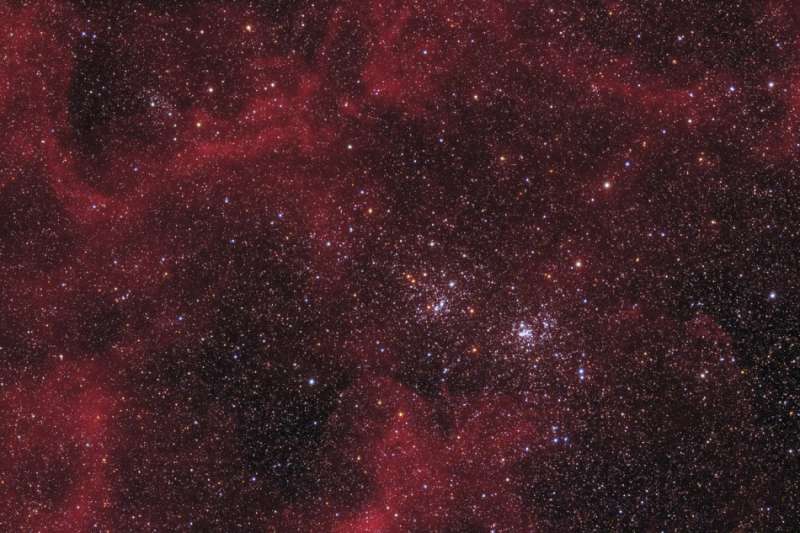Credit & Copyright: Fabian Neyer
Explanation:
This
lovely starfield
spans some seven full moons (about 3.5 degrees) across the
heroic northern constellation of
Perseus.
Just right of center it holds the famous pair of open or galactic
star clusters, h and Chi Perseii.
Also cataloged as
NGC
869 (right) and NGC 884,
both clusters are about 7,000 light-years away and
contain stars much younger and hotter than the Sun.
Separated by only a few hundred light-years, the clusters are
both 13 million years young
based on
the ages of
their individual
stars,
evidence that they were likely a product of the same
star-forming region.
Always a rewarding
sight in binoculars,
the Double Cluster is
even visible to the unaided eye from
dark locations.
Not seen in binoculars though, and not often depicted in
telescopic images of the region are faint clouds of reddish ionized
hydrogen gas found throughout this remarkable cosmic skyscape.
A color composite, the image includes narrowband data to
enhance emission from the hydrogen clouds.
Visible toward the upper left of the wide
field of view is
another, smaller open star cluster,
NGC 957,
also of similar age, distance, and possibly related
to the more famous Double Cluster in Perseus.
1999 2000 2001 2002 2003 2004 2005 2006 2007 2008 2009 2010 2011 2012 2013 2014 2015 2016 2017 2018 2019 2020 2021 2022 2023 2024 2025 |
Yanvar' Fevral' Mart Aprel' Mai Iyun' Iyul' Avgust Sentyabr' Oktyabr' Noyabr' Dekabr' |
NASA Web Site Statements, Warnings, and Disclaimers
NASA Official: Jay Norris. Specific rights apply.
A service of: LHEA at NASA / GSFC
& Michigan Tech. U.
|
Publikacii s klyuchevymi slovami:
open cluster - star cluster - Persei - Rasseyannoe skoplenie
Publikacii so slovami: open cluster - star cluster - Persei - Rasseyannoe skoplenie | |
Sm. takzhe:
Vse publikacii na tu zhe temu >> | |
